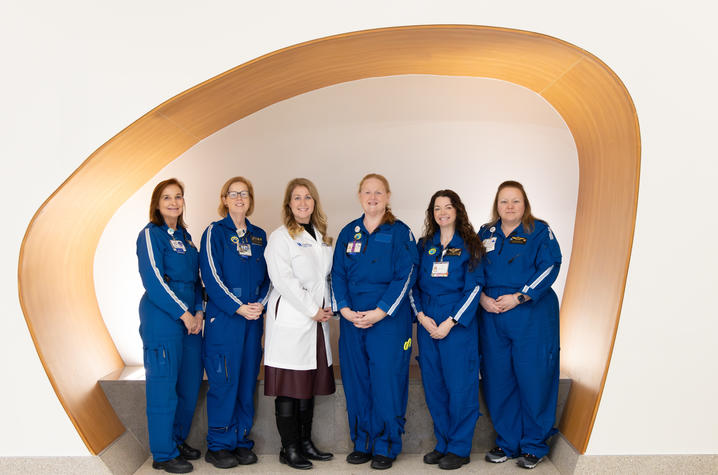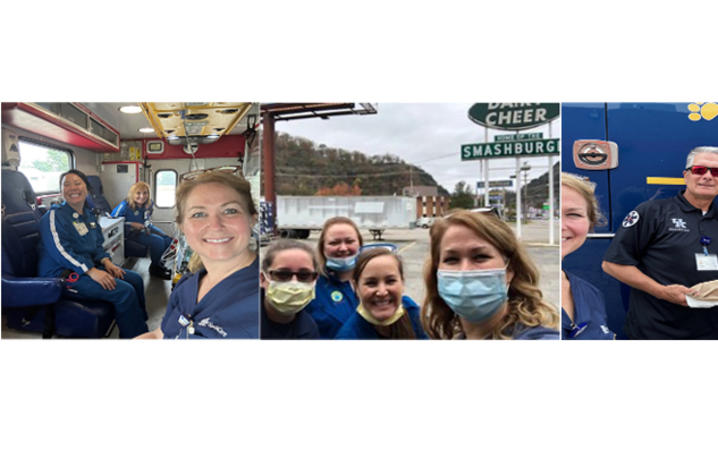Pediatric end-of-life home transport empowers grieving families with dignity, choice
LEXINGTON, Ky. (Jan. 7, 2025) – The long, winding driveway. The smell of the hanging flower baskets on the front porch. Lindsay Ragsdale, M.D., remembers every detail of that day — one of the most important and sensitive excursions of her professional life.
As division chief of Pediatric Palliative Care at Kentucky Children’s Hospital (KCH), she and her team have had more than their share of helping families navigate the most painful, heart-wrenching experience imaginable — the death of a child.
But this one was different. In the lush Appalachian hills, in the warmth of the old family home, surrounded by the comfort of loved ones, Ragsdale faced a young newborn, stricken with congenital anomalies that were incompatible with life, and she gently removed her breathing tube. Held close by her mother, the baby’s cheeks turned from pink to gray as her little heart slowed to a stop. Family gathered around to say their first hello and last goodbye. As with every passing to which she has borne witness, Ragsdale was struck by the unfairness of it all. Not only did these parents already lose another infant child, but they were also denied more time with this one. But then the baby’s mother spoke, rousing Ragsdale from her thoughts.
“It’s OK, Dr. Ragsdale,” the young mother said. “I knew this was going to happen. But I am grateful to be able to bring her home.”
Gesturing to the scores of family members in attendance at the family home where hummingbirds buzzed around the hanging flower baskets, the baby’s mother gave Ragsdale and her team permission to share in the family’s celebration of life full of love, however short it might have been.
***
For families grappling with choices for end-of-life care for their child, one decision is the hardest to grant — the location of their child’s passing.
Studies show that 70% of pediatric patients die in the hospital; most of these involve some removal of technology at the end of life. Some families instead want to have their child at home during their last moments of life, surrounded by the people and things that give them the most comfort.
To help families facilitate a dignified, peaceful passing for their child, the KCH Pediatric Advanced Care Team offers families the option of transporting them home on life-sustaining technology. Once home, the support is removed, allowing the child to pass naturally and peacefully, surrounded by their family’s love and home’s comfort. These end-of-life home transports involve an intense amount of coordination with multiple agencies and specialties, but the impact can be immense for families who are able to have their child at home and comfortable at the end of life.
“Our team has facilitated many home transports over the past five years,” said Ragsdale. “Many families have had the opportunity to meet extended family at home for the first time. They have had time at home with their child and have their last moments surrounded by love and family.”
Transporting a medically frail child is an intricate, unpredictable procedure requiring expert planning, communication, advance care planning, symptom management, and complex care coordination. The critical care transport team, along with the patient’s primary medical team, transport team, palliative care team, work with the local hospice agency to assess a patient’s candidacy for transport.
As transports of critically ill patients are very complicated operations, the team uses a detailed checklist to ensure a smooth and safe journey. Prior to scheduling a transport, Ragsdale and her team notify key stakeholders, including hospital administration, the local hospice agency and the local coroner. The patient’s parents or guardians complete an informed consent procedure, acknowledging that their child may not survive the journey home.
The transport crew, a team of experienced professionals who administer critical care on the go, will assess the destination — usually the family’s home. How long is the driveway? Does the house have tight corners? Are there enough electrical outlets in the child’s room? How many other family members and pets will be in the house? If, once home, the child does not pass after the discontinuation of life-sustaining treatment, families are connected to local hospice caregivers to continue care at home.
“Every transport is a logistical challenge,” said Dan Andrews, manager of neonatal and pediatric transport for KCH. “Our crews adapt to every situation with skill and sensitivity, ensuring families are supported with dignity and grace during these complex and delicate transitions.”
If the child is not doing well during transport, contingencies are discussed to ensure the patient remains as comfortable as possible.
“The transport crew and palliative care providers on board support comfort with the goal of getting the patient home,” said Ragsdale. Medications to relieve discomfort are administered as needed. Discussions with the family take place prior to leaving about the plans for how to care for the child and family if the child declines or dies enroute; the patient will be supported as they pass naturally and peacefully without resuscitation efforts.
Few children’s hospitals offer palliative transport. Financial barriers can be significant. End-of-life transport is not considered emergency transport and is therefore not routinely covered by insurance. The average cost of a “local” transport can be $500-$5,000, and cross-country flights can start at $15,000-$125,000. While partnerships with charitable organizations such as Angel Flight can be engaged, some institutions are able to assume the costs of transport to ensure there is no financial burden on the families, or coordinate with Kentucky’s Medicaid program for reimbursement.
Logistical barriers exist, especially when coordinating with multiple internal and external agencies. Ensuring medication safety is an important step. Not all hospice agencies have robust training for pediatric cases, and families may not be prepared to provide 24/7 care should the child not pass shortly after the withdrawal of life-sustaining treatment. Families also will grapple with the grief of losing a child in their home. Bereavement support is offered by hospice for the year after their child’s death.
Finally, there is the intangible factor — the impact on the transport team, especially if the patient dies en route to their home.
“Our teams are accustomed to rushing to the hospital to save a life, not driving to the patient’s home to facilitate the end of a life,” said Andrews. “This kind of transport is not routine and needs intentional support for the members of the team.”
Education and support resources are developed as the program continues to grow and evolve. The palliative team travels on all these transports and has established close personal and working relationships with the transport team; members of the transport crew will volunteer to join palliative care team for these important — and delicate — journeys.
While not every terminally ill or injured child is a candidate for this kind of transport, honoring a family’s preference to bring their child home may help provide some closure and mitigate some of the grief and trauma that can come with the passing in a hospital setting.
“The end-of-life home transport program at Kentucky Children’s Hospital is more than a service — it’s a testament to compassionate, patient-centered care,” said Ragsdale. “In a world where care often ends at the hospital doors, our home transport program opens another path — one filled with love, choice and dignity, and ensuring families can be where their hearts long to be.”
UK HealthCare is the hospitals and clinics of the University of Kentucky. But it is so much more. It is more than 10,000 dedicated health care professionals committed to providing advanced subspecialty care for the most critically injured and ill patients from the Commonwealth and beyond. It also is the home of the state’s only National Cancer Institute (NCI)-designated Comprehensive Cancer Center, a Level IV Neonatal Intensive Care Unit that cares for the tiniest and sickest newborns, the region’s only Level 1 trauma center and Kentucky’s top hospital ranked by U.S. News & World Report.
As an academic research institution, we are continuously pursuing the next generation of cures, treatments, protocols and policies. Our discoveries have the potential to change what’s medically possible within our lifetimes. Our educators and thought leaders are transforming the health care landscape as our six health professions colleges teach the next generation of doctors, nurses, pharmacists and other health care professionals, spreading the highest standards of care. UK HealthCare is the power of advanced medicine committed to creating a healthier Kentucky, now and for generations to come.






